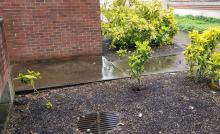Cause Phytophthora spp., fungal-like organisms that thrive in water saturated soil and/or poor drainage conditions. Several different species have been identified throughout the world on Aucuba. The organism infects at the tips, middle and junctions of lateral root branches. Entire roots become necrotic as the pathogen colonizes the tissue. Depending on the species, the pathogen may continue up into the stems causing the plant to collapse and die.
Symptoms Above ground symptoms include wilting of the canopy, blackened leaves, branch dieback and eventually plant death. Plants may be dwarfed and decline gradually when planted in the ground but collapse suddenly when growing in containers. In some cases, the vascular cambium becomes necrotic at the root collar causing a collar rot. Roots may turn necrotic and rot with the outer tissue sloughing off the stele when squeezed between the fingers.
Cultural control Use many different tactics to manage root rots but focus efforts on water management.
- Provide good drainage for plants in landscapes, beds, fields, or containers. Rapid drainage of container media throughout the production cycle of the crop is critical.
- Avoid areas where drainage is poor or increase drainage with tiling.
- Use raised beds in landscape plantings.
- Use composted hardwood or conifer bark. The suppressive effect should last about 1 year at which time potted plants may be repotted into fresh media.
- Avoid reusing pots from a previous crop for propagation. If pots must be reused then wash off all debris and soak in a sanitizing solution or treat with aerated steam for 30 min.
- Prevent potted plants in nurseries from falling over allowing foliage to touch the ground.
Chemical control Use fungicides as preventative treatments. The Group 4 and Group P7 fungicides used to manage Phytophthora do not kill this organism. They can only prevent establishment of the organism before it gets into the plant. They can also prevent continued growth if the organism is already inside the plant thereby delaying symptoms that might have developed. Once chemical activity has subsided with time, the organism can resume growth within infected plants. Alternate or tank-mix products from different groups that have different modes of action. Limit the use of any one group during crop production.
- Banrot 40 WP at 6 to 12 oz/100 gal water. Group 1 + 14 fungicide. 12-hr reentry.
- Empress at 1 to 3 fl oz/100 gal water can be used for cuttings or seedlings. Group 11 fungicide. 12-hr reentry.
- Fosphite at 3 quarts/100 gal water. Do not use copper products within 20 days of treatment. Group P7 fungicide. 4-hr reentry.
- Mefenoxam 2 AQ at 0.98 to 1.96 fl oz/100 gal water as a soil drench or at 1.23 to 2.45 fl oz/1,000 sq ft followed by at least 0.5 inch rain or irrigation. Group 4 fungicide. No restrictions on reentry when used as a soil drench or media incorporation.
- MetaStar 2E at 1 to 2.5 fl oz/100 gal water and apply as a drench. Group 4 fungicide. No restrictions on eentry when used as a soil drench or media incorporation.
- Monterey Garden Phos at 2 to 4 teaspoons/gal water as a foliar spray. Also labeled for soil drench, see label for details. Can be used in landscape sites. Group P7 fungicide. H
- Subdue MAXX at 1.25 to 2.5 fl oz/1,000 sq ft, irrigated in with 0.5 inch water within 24 hours. Group 4 fungicide. No restrictions on reentry when used as a soil drench.
- Terrazole 35 WP at 3.5 to 10 oz/100 gal water. Group 14 fungicide. 12-hr reentry.
Biological control Use in combination with other tactics. Will not be effective under high-disease pressure. Products usually contain specific species of organisms antagonistic to Phytophthora, including Trichoderma, Pseudomonas, and Bacillus species.
- RootShield Plus Granules (Trichoderma harzianum Rifai strain T-22 and T. virens strain G-41) at 1 to 3 lb/cubic yard of soil mix or 0.5 to 7.5 lb/1,000 sq ft. No restrictions on reentry required when soil incorporated. O
- Bio-Tam 2.0, Tenet WP, or Obtego (Trichoderma asperellum and T. gamsii) is registered and may be effective. Use 0.5 to 1.5 lb/cubic yard of substrate. See label for details. No restrictions on reentry when soil incorporated. O
Reference Henricot, B., Pérez Sierra, A. and Jung, T. 2014. Phytophthora pachypleura sp. nov., a new species causing root rot of Aucuba japonica and other ornamentals in the United Kingdom. Plant Pathology, 63:1095-1109.


